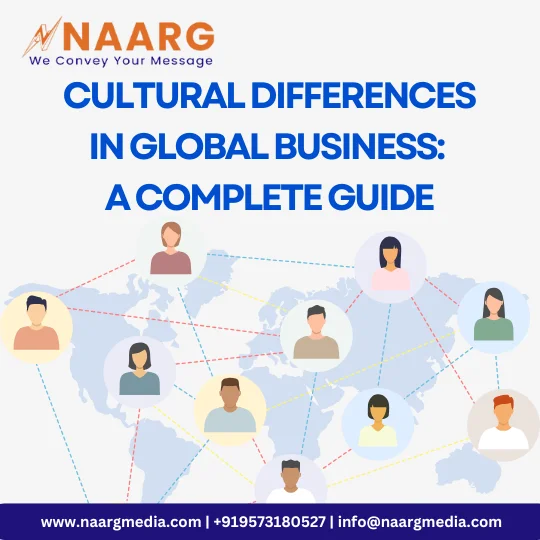Cultural differences in global business are the first thing you must know and navigate to expand globally. Because what resonates in one country might fall flat in another, or worse, it might offend your target audience.
Take KFC’s example; its slogan ‘Finger-licking good’ was mistranslated in China to ‘Eat your fingers off’. This particular instance caused quite the cultural confusion. These examples cannot be isolated as they highlight how cultural misinterpretations can impact even the most iconic brands.
If you are a business planning to expand globally, use these cases to understand the importance of cultural awareness.
This blog will help you understand why cultural differences in global business are crucial to understand to expand your business.

What Is Cross-Cultural Business?
According to the definition, cross-cultural business refers to the collaborations and interactions between individuals or companies from different cultural backgrounds.
It is all about understanding, respecting, and adapting to cultural differences in values, communication styles, decision-making processes, and expectations.
In a report by McKinsey, businesses that embrace diversity and cultural inclusivity are 35% more likely to outperform their competitors in profitability.
Embracing this cross-cultural communication helps you avoid cultural differences and promotes innovation and stronger partnerships to reach a broader audience.
The Importance of Understanding Cultural Differences in Business
Having cultural sensitivity in your business is crucial, but the question is why there is so much emphasis on understanding cultural differences in business.
It is no longer just about nice to have a phenomenon for your business; rather, it has become a competitive necessity. Every culture brings its own set of values to the table, and if you fail to address those cultural differences in your business, the chances of your business falling flat are huge.
Always remember this rule: what works in one country might not be perceived well in another country. Once you make your business culturally aware, you not only create positive first impressions but also pave the way for long-lasting and meaningful relationships across borders.
Remember, understanding cultural differences in business is a strategic advance and not just a benefit.
Dimensions of Cultural Differences
First, let’s understand what the dimension of cultural differences is. These dimensions provide a framework for understanding how values, behaviors, and practices vary across cultures. These dimensions were first introduced by social psychologist Geert Hofstede and then further explored by others.
Now, let’s have a look at all the dimensions of cultural differences.
1. Power Distance
Power distance measures how comfortable people are in a society with inequality and organizational hierarchy structures. In countries with high power distance cultures, people often accept hierarchical roles and respect authority without question.
Whereas in countries with low power distance cultures, people value equality and are more likely to question authority.
2. Individualism vs. Collectivism
Some countries, like the United States and the United Kingdom, possess individualistic cultures and emphasize personal freedom, autonomy, and individual achievement.
Whereas collectivist countries like South Korea and Japan prioritize group harmony, loyalty, and collective well-being over individual pursuits.
3. Masculinity vs. Femininity
Further, these dimensions also explore a society’s preference for traditionally masculine values versus feminine values. Many countries rank high in masculinity, focusing on criteria that involve masculinity.
This dimension can also be known as gender egalitarianism, in which male and female equality is actualized.
4. Uncertainty Avoidance
There are cultures with high uncertainty avoidance, like Greece and Portugal. These countries prefer clear rules, stability, and structured environments to minimize risk and uncertainty.
On the other hand, societies like Singapore and Jamaica, which have low levels of uncertainty avoidance, are more at ease with ambiguity, creativity, and taking chances.
5. Long-Term vs. Short-Term Orientation
Now come the long-term and short-term-oriented cultures. Long-term-oriented cultures focus on future rewards, perseverance, and frugality that solely emphasize long-term goals and endurance.
Whereas short-term-oriented cultures are more focused on immediate outcomes, quick results, and preserving social norms.
6. Indulgence vs. Restraint
Allowing for relatively free expression, enjoyment of life, and prioritizing personal happiness is known as indulgent culture.
Restrained cultures often impose social norms that limit gratification and encourage self-discipline and moderation.
Key Cultural Differences and Their Impact on Business
It has become crucial to understand cultural differences if you have a business and wish to expand in a global environment.
Let’s have a look at some key cultural differences and their impacts on business.
1. Communication Styles
Communication styles are different in many countries. Some countries value clarity and straightforwardness, where business discussions are often explicit and feedback is direct.
Whereas in some countries there is a culture where context and nuance are important. Politeness, preserving harmony, and non-verbal communication often take precedence over directions.
Distinct communication styles have a great impact on business. For instance, you cannot have a direct approach in a country where indirect communication is perceived. It will come out as rude and will potentially damage your business relationships.
2. Time Orientation
Some cultures prioritize time, punctuality, and deadlines. In these cultures, time is seen as a commodity, and these cultures are known as monochronic.
Some countries, like Latin America and the Middle East, are more flexible with time. These cultures are known as polychronic, and relationships and interactions in these cultures may take precedence over adherence to schedules.
So, when you have a global business, always try to understand the time orientation of different cultures.
3. Risk Tolerance
Some countries view risk tolerance as an opportunity for growth, like the USA and Australia. These countries tend to embrace innovation and change as they have a high-risk tolerance.
While some countries are generally more risk-averse, they favor stability and cautious planning. So, if you are entering into new markets, try to analyze the attitude of your market and audience toward risk.
Especially if you have a bold marketing strategy, it is better to look out for the risk tolerance of the new market.
Attention to detail can determine the success of your business on an international scale. And to understand the cultural differences in global business, attention to detail is the key.
Understanding customer preferences and emotional intelligence are some of the first and essential steps for thriving in global markets.
At Naarg, we specialize in translation and localization services that ensure your message resonates with audiences across cultures.
Contact us today and tell us about your business goals, and let’s explore how we can support your growth journey.

